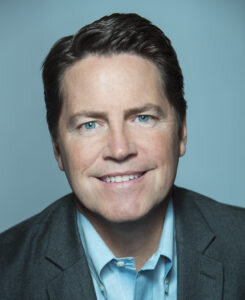Seven Questions With Hulu's Peter Naylor
If there’s any one company that sits at the heart of the ad-supported OTT ecosystem, it’s Hulu.
Peter Naylor, Hulu’s SVP and Head of Advertising Sales has seen the industry grow from “what’s that?” to “I want it.” Naylor asserts that the march to addressable is inevitable. “I can’t imagine a scenario where every television household in American isn’t someday connected to an IP address.”
Naylor decries what he calls the “short-termism” of many in the industry, people who are just looking weeks ahead rather than years. “It takes courage to disrupt all the things that have worked for decades,” he says. “But if you follow the viewer, then you can’t go wrong.”
That doesn’t mean Naylor expects the whole system to blow up. Take the upfronts for instance. “Even in a 100% addressable universe, there are always going to be audience segments where there’s more demand than supply. And so marketers are still going to want to ensure they secure partnerships that give them access to coveted audiences.”
Finally, Naylor sees a renewed role for creativity, both in the types of ads that brands can run on OTT (“anything that you can do on a browser, you can do on OTT,” he says) and in the renewed attention to storytelling and brand building, as knowing how to manage data reverts to just being “table stakes.”

What is the biggest opportunity right now around OTT advertising?
The biggest opportunity is around creative, to capitalize on what you can do in a browser and beyond —interactive ads, behavioral targeting, a brand presence in a pause experience. OTT offers a range of creative options you don’t have on traditional linear. Marketers are still in the early stages of fully appreciating what’s possible when they can reach the entire audience via an IP address.
What percentage of TV advertising is going to become addressable by 2020?
Addressable advertising is going to accelerate rapidly due to several potential developments such as: (a) the coming promise of 5G, (b) ATSC 3.0, which has elements that are addressable, and (c) the slow steady decline of the pay TV package as we know it, because most people won’t stop watching TV, they’ll just stop watching TV the old way and the new ways are all addressable.
Some combination of all of the above will accelerate the move to addressable over the next few years. I don’t know what the percentage will be in two years or how long it will take us to get to a fully addressable future, but I know the market is undeniably going in one direction.
What is Hulu doing to transform addressable advertising?
The first thing we’re doing is educating the market on the power of targeting capabilities in OTT. We’ve found some local businesses that were cautious to allocate their television budgets to Connected TV because of perceived complexity and cost. And we’ve also found a few digitally-native direct-to-consumer brands who were unsure about the breadth and depth of targeting in OTT. What they’ve come to find out is that Hulu offers the best of both television and digital; OTT should be their first stop for adding TV to their marketing mix.
What is going to happen to the upfronts in this new on-demand, addressable OTT world?
The upfront market will continue to exist because partnerships are largely built around the ideas of scarcity and supply and demand. There will always be audience segments that people will want to lock-in to meet their marketing objectives in advance — whether it’s automobile buyers, primary grocery shoppers, frequent business travelers — even in a fully-addressable world, you will still have all these highly coveted segments with more demand than supply, and they will be sold in an upfront manner.
What’s wrong with the conversation around OTT right now?
One key problem is what I call “short-termism”— so many businesses are living a quarter-to-quarter existence. These companies need to realize that their current business is not going to be the same for much longer. Without the courage to disrupt your quarter-to-quarter existence, you will be sitting there planning for the next quarter with an old playbook while the consumer races ahead. A quarter-to-quarter pace is no longer fast enough. Pay attention to the viewers. The viewers will lead you where you need to go next.
Is there too much emphasis on retail/ DR versus image advertising on OTT?
Brand building and storytelling are always critical. I remember when the now retired CMO of Fidelity, Jim Speros, said something a few years back when everyone was talking about “big data” that stuck with me. He advised that everyone’s going to have to be great at data because if they’re not, they will be out of business. Being good at data is table stakes. But once everyone’s great at data you know what determines the winners? Creativity, brand building and storytelling.
Who will control OTT budgets: TV buyers, digital buyers or a hybrid “advanced TV buyer”?
If you look 12 or even 24 months down the road, video agnosticism will truly begin to take hold in practice.
The rise of addressable inventory and the collapse of gross rating points as a measurement standard are going to create a shift, and you’ll have a new breed of data-informed and audience-centric buying. The whole ecosystem will continue to evolve rapidly. That’s when we’ll see the role of an advanced video specialist for OTT become widespread.
GET OUR TVREV SPECIAL REPORT ON AD SUPPORTED OTT. You'll never talk or think about OTT the same way again.